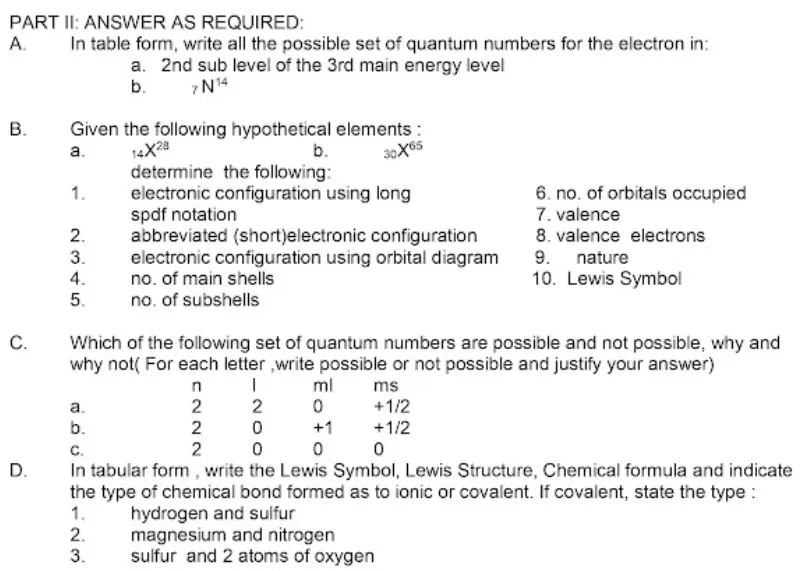In tabular form, write the Lewis Symbol, Lewis Structure, Chemical formula and indicate the type of chemical bond formed as to ionic or covalent. If covalent, state the type : 1. D. 2. 3. hydrogen and sulfur magnesium and nitrogen sulfur and 2 atoms of oxygen
In tabular form, write the Lewis Symbol, Lewis Structure, Chemical formula and indicate the type of chemical bond formed as to ionic or covalent. If covalent, state the type : 1. D. 2. 3. hydrogen and sulfur magnesium and nitrogen sulfur and 2 atoms of oxygen
Chemistry by OpenStax (2015-05-04)
1st Edition
ISBN:9781938168390
Author:Klaus Theopold, Richard H Langley, Paul Flowers, William R. Robinson, Mark Blaser
Publisher:Klaus Theopold, Richard H Langley, Paul Flowers, William R. Robinson, Mark Blaser
Chapter6: Electronic Structure And Periodic Properties Of Elements
Section: Chapter Questions
Problem 41E: Consider the orbitals shown here in outline. (a) What is the maximum number of electrons contained...
Related questions
Question
I need answer in letter D (1,2,3)

Transcribed Image Text:PART II: ANSWER AS REQUIRED:
А.
In table form, write all the possible set of quantum numbers for the electron in:
a. 2nd sub level of the 3rd main energy level
b.
7N14
Given the following hypothetical elements :
a.
В.
14X28
determine the following:
electronic configuration using long
spdf notation
abbreviated (short)electronic configuration
electronic configuration using orbital diagram
no. of main shells
no. of subshells
b.
6. no. of orbitals occupied
7. valence
8. valence electrons
1.
2.
9. nature
10. Lewis Symbol
3.
4.
5.
C.
Which of the following set of quantum numbers are possible and not possible, why and
why not( For each letter ,write possible or not possible and justify your answer)
ml
ms
а.
2
2
+1/2
b.
2
+1
+1/2
C.
In tabular form , write the Lewis Symbol, Lewis Structure, Chemical formula and indicate
the type of chemical bond formed as to ionic or covalent. If covalent, state the type :
1.
2.
3.
2
D.
hydrogen and sulfur
magnesium and nitrogen
sulfur and 2 atoms of oxygen
Expert Solution
This question has been solved!
Explore an expertly crafted, step-by-step solution for a thorough understanding of key concepts.
Step by step
Solved in 2 steps with 1 images

Knowledge Booster
Learn more about
Need a deep-dive on the concept behind this application? Look no further. Learn more about this topic, chemistry and related others by exploring similar questions and additional content below.Recommended textbooks for you

Chemistry by OpenStax (2015-05-04)
Chemistry
ISBN:
9781938168390
Author:
Klaus Theopold, Richard H Langley, Paul Flowers, William R. Robinson, Mark Blaser
Publisher:
OpenStax

Principles of Modern Chemistry
Chemistry
ISBN:
9781305079113
Author:
David W. Oxtoby, H. Pat Gillis, Laurie J. Butler
Publisher:
Cengage Learning

Chemistry: The Molecular Science
Chemistry
ISBN:
9781285199047
Author:
John W. Moore, Conrad L. Stanitski
Publisher:
Cengage Learning

Chemistry by OpenStax (2015-05-04)
Chemistry
ISBN:
9781938168390
Author:
Klaus Theopold, Richard H Langley, Paul Flowers, William R. Robinson, Mark Blaser
Publisher:
OpenStax

Principles of Modern Chemistry
Chemistry
ISBN:
9781305079113
Author:
David W. Oxtoby, H. Pat Gillis, Laurie J. Butler
Publisher:
Cengage Learning

Chemistry: The Molecular Science
Chemistry
ISBN:
9781285199047
Author:
John W. Moore, Conrad L. Stanitski
Publisher:
Cengage Learning

Chemistry: An Atoms First Approach
Chemistry
ISBN:
9781305079243
Author:
Steven S. Zumdahl, Susan A. Zumdahl
Publisher:
Cengage Learning


Chemistry
Chemistry
ISBN:
9781305957404
Author:
Steven S. Zumdahl, Susan A. Zumdahl, Donald J. DeCoste
Publisher:
Cengage Learning